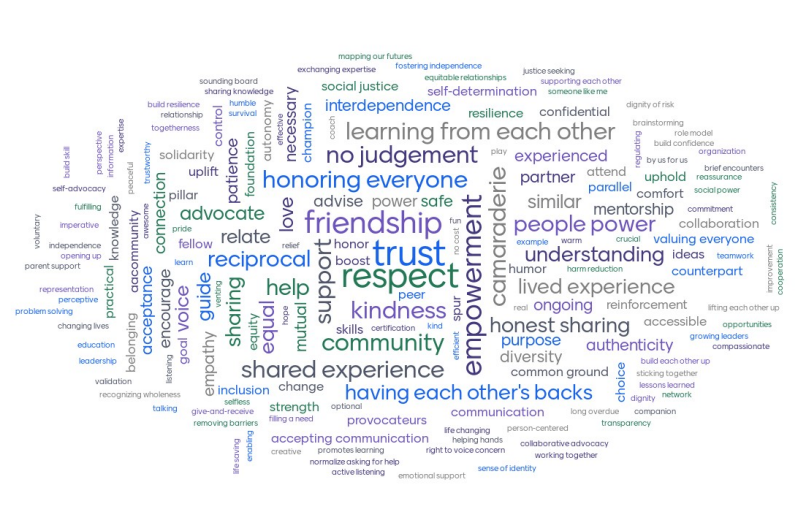Oregon Health & Science University’s UCEDD, with our partner CommunicationFIRST, have released a final written report outlining the findings and recommendations of the Augmentative and Alternative Communication (AAC) Peer Support Project, which took place between February 2024 and March 2025.
Advancing the use of peer support models for people who use or need AAC to communicate
Funded by the U.S. Administration for Community Living and implemented through a contract with the Association of University Centers on Disabilities (AUCD), the goal of the AAC Peer Support Project was to advance the use of peer support models for people who use or need AAC through the creation of a nationwide, comprehensive, consensus-based approach. We sought to answer the questions: (1) What peer supports exist for AAC users now? and (2) Can we create a nationwide resource for developing peer support models for people who use or need AAC?
We established a nationwide Consortium of approximately 60 individuals representing over 30 organizations, including 23 AAC users and a wide range of stakeholders from the broader AAC community. Treating AAC users as AAC experts and prioritizing AAC user leadership and perspectives has been vital to the success of this project. Hear what some of our Consortium members had to say about this collaboration:
"So proud to attend a meeting that was about the experiences and opinions of AAC users rather than talkies. Moved the power where it should be for the final product."
"Each week we uncover more layers to the complexity of AAC and AAC users. So blessed to be part of this committee."
"So happy to move this agenda forward, taking back our power, we are fully AAC-tivated!"
The process of developing our recommendations included conducting a ground-breaking AAC user survey with key questions about what tools and techniques AAC users use to communicate and about their experiences with AAC peer support models.
We conducted a systematic literature review to identify research gaps, inform future studies, and guide the development or adaptation of AAC Peer Support models. We defined AAC peer support and the basic values of peer support, established key and preferred terms, compiled a list of resources and information, and identified barriers and facilitators to AAC peer support. The results of this work culminated in the development of 10 actionable recommendations for a national plan to advance AAC peer supports.
Findings and recommendations outlined in the final written report
We found that AAC peer support activities alone will not ensure successful and effective AAC acquisition and use. In addition to supporting AAC Peer Support activities, it is critical to provide support for AAC advocacy, legislation and policy. This must include AAC user-led training for professionals, mentoring opportunities provided by AAC users in schools, homes, and employment sites, evaluation of activities by AAC users, and funding for sustainability. Below we list 10 actionable, practical recommendations for ways AAC peer support could be improved and increased for AAC users:
- Recommendation #1: Establish a Center of Excellence for AAC Peer Support. This center will serve as a national leader in development, implementation, evaluation and dissemination of AAC Peer Support activities, and will enhance collaboration among networks. The center should focus on developing and evaluating peer support activities, policy advocacy to improve communication access and the availability of AAC Peer Support, and strengthening AAC Peer Support activities through technical assistance.
- Recommendation #2: Build a core leadership team composed of AAC users, family members, and professionals to ensure the Center’s initiatives are aligned with community needs. Maintain existing advisory committees to direct the center’s activities and evaluate peer support projects.
- Recommendation #3: Create a mechanism to provide community mini-grants that sustain AAC Peer Support activities and incubate novel programs. Establish a means to distribute mini-grants for initiatives that sustain AAC Peer Support projects, reduce access barriers, and develop new programs. For example, mini-grants can be provided to reduce travel costs, develop extension activities to sustain relationships built during AAC camp, and fund peer support activities in states where Medicaid waivers do not support AAC services. The Center of Excellence for AAC Support should provide technical assistance for writing and administering mini-grants. The grant review committee should include members who use AAC and their families. There is a precedent at the OHSU UCEDD Community Partners Council, which provides mini-grants to community organizations.
- Recommendation #4: Increase inclusion of people who need AAC in multiply marginalized communities by conducting community engagement studios to address support needs. A Community Engagement Studio (CES) is a model for engaging community members in collaborations between professionals, AAC users, and their networks that focus on evaluating program components through listening sessions. The CES approach can identify successful features of AAC Peer Support activities to accommodate the unique needs of these populations.
- Recommendation #5: Develop an Implementation Toolkit for AAC Peer Support. We recommend developing an Implementation Toolkit consisting of resources, practical tools, and self-assessment checklists to increase accessibility of peer support activities for anyone interested in starting, maintaining, funding, or evaluating AAC Peer Support activities. A Toolkit could direct the uptake and sustainability of peer support activities and likely lead to more successful acquisition of and effective use of AAC.
- Recommendation #6: Create family-centered peer support activities. Peer support is needed among families and others who support AAC users (i.e., paraeducators, direct support professionals, nurses). Family-centered approaches like those in AAC camps, provider organizations, and Family to Family Networks should be utilized to enable participants to connect with peers.
- Recommendation #7: Establish a repository for AAC users who are interested in being peer mentors within AAC Peer Support activities. Many people who need AAC have never interacted with an AAC user. We recommend creating a repository of AAC users, detailing their locations, tools, techniques, and availability to connect, modeled after networking efforts like the U.S. Society for AAC (USSAAC) Speakers Bureau and the PRC-Saltillo (AAC manufacturer) Ambassador Program.
- Recommendation #8: Create an AAC Peer Support hub to increase means to find AAC Peer Support activities. A virtual hub similar to the Commit to Connect Champions (committoconnect.org) and Patient Connect (polygonhealth.app) should be created that lists contact information for peer support activities. The hub should provide information on a wide variety of AAC Peer Support activities.
- Recommendation #9: Host a bi-annual conference about AAC Peer Support. An online or hybrid conference should be convened with three goals: (1) Offer training and consultation to AAC users and their networks; (2) Provide networking opportunities; (3) Set implementation, dissemination, advocacy, and policy priorities.
- Recommendation #10: Implement a rigorous evaluation framework using outcome measures specified by the AAC community. Evaluation of AAC Peer Support activities must be conducted from the lens of AAC users. Evaluating participation, engagement, and goodness of fit can provide useful outcome measures.
Outcome measures should be focused on subjective quality of life outcomes (i.e. sense of self, choice, autonomy, agency, privacy, trust, camaraderie, well-being) rather than an increase in opportunities to use AAC to communicate or access to AAC. A sample self-assessment tool was designed to encourage reflection on individual goals and goodness of fit of an AAC peer support activity.
Bonus: New tool for prioritizing AAC users in group discussions
In addition to our recommendations for advancing AAC peer support activities, the Consortium developed guidelines for virtual meetings between AAC users and people who can rely on speech. These guidelines prioritize AAC user perspectives in discussions and the Consortium agreed this empowered people who use AAC. A member told us, “I can honestly say that this Consortium has been the most accessible meeting I have attended, and it is not even close." We are pleased to share the guidelines for others to use or adapt for their meetings.
Download Guidelines for the Prioritization of AAC Users in Group Discussions
Access the final written report, executive summary, and a plain language version
Explore the full text of the final written report, an executive summary, or a plain language version of the executive summary for more details about the findings and recommendations for a national plan to advance peer supports for people who need or use AAC.
Download Final Written Report
Download Executive Summary
Download Plain Language Executive Summary










